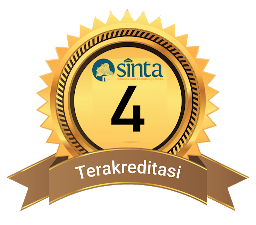Analisis Instrumen Spektra FTIR Dan GC-MS Senyawa Kalkon Hasil Sintesis dari Vanilin dalam Majalah Kimia: Suplemen Perkuliahan Kimia Organik Lanjut
DOI:
10.29303/cep.v8i1.8711Published:
2025-05-31Issue:
Vol. 8 No. 1 (2025): Edisi MeiKeywords:
FTIR dan GC-MS Interpretation, Chalcone Coumpounds, Chemistry Magazine.Articles
Downloads
How to Cite
Abstract
This study aims to analyze chalcone compound instruments and develop a chemistry magazine as supplementary reading material for students. The research adopts the 4D development model, which consists of four stages: define, design, develop, and disseminate. The magazine was validated by three lecturers from the Chemistry Education and FMIPA study programs, while student response testing was conducted on 47 Chemistry Education students at the University of Mataram. The validation results using Aiken’s V index indicate a score of 0.83, categorized as highly valid. Additionally, the magazine's feasibility level reached 90.03%, classified as highly practical. Therefore, this chemistry magazine is suitable as supplementary reading material in chemistry learning.
References
Ahmad, A. (2023). Penerapan Metode Problem Solving dalam Meningkatkan Aktivitas Belajar Siswa Mata Pelajaran PPKn Materi Pentingnya Keutuhan NKRI di SDN Temba Kelas V Semester 1 Tahun Ajaran 2016/2017. Jurnal Pendidikan Dan Pembelajaran Indonesia (JPPI), 3(1), 135–144.
Anggoro, B. S., Bidayati Haka, N., & Hawani, H. (2019). Pengembangan Majalah Biologi Berbasis Al-Qur’an Hadist Pada Mata Pelajaran Biologi Untuk Peserta Didik Kelas X Di Tingkat SMA/MA. Biodik, 5(2), 164–172.
Arsyad, A. (2014). Media Pembelajaran. Jakarta: Rajawali Pers.
Arty, I. S., & Rohmawati, D. (2014). Optimalisasi Waktu Reaksi Kondensasi antara Vanilin dan P-Nitroasetofenon dalam Katalis Asam. Jurnal Sains Dasar, 3(1), 34-38. Ramli. (2012). Media dan Teknologi pembelajaran. IAIN Antasari Press.
Darmapatni, K. A. G. (2016). Pengembangan Metode GC-MS untuk Penetapan Kadar Acetaminophen pada Spesimen Rambut Manusia. Jurnal Biosains Pascasarjana, 18(3), 255. https://doi.org/10.20473/jbp.v18i3.2016.255-266
Dona, R., & Jasril, A. Z. (2015). Sintesis dan Uji Toksisitas Senyawa Analog Kalkon Tersubstitusi Metoksi. Jurnal Pothon, 5(2), 121–153.
Ekanayake, I. U., Meddage, D. P. P., & Rathnayake, U. (2022). A Novel Approach to Explain the Black-Box Nature of Machine Learning in Compressive Strength Predictions of Concrete Using Shapley Additive Explanations (SHAP). Case Studies in Construction Materials, 16, e01059.
Fatmawati, L. (2013). Pengembangan Bahan Ajar Modul Elektrokimia untuk Siswa SMA Kelas XII IPA dengan Pendekatan Pembelajaran Inkuiri Terbimbing. Jurnal Pendidikan Sains, 1(2), 109–120.
Golung, A. (2015). Studi Tentang Pemanfaatan Majalah Ilmiah di UPT Perpustakaan UNSRAT Manado. Jurnal Acta Diurna, IV(1).
Hadisaputra, S., Andayani, Y., Junaidi, E., Fara, B., & Sofia, D. (2022). Pelatihan Peningkatan Kemampuan Penulisan Karya Ilmiah dan Teknik Publikasi bagi Mahasiswa Program Studi Pendidikan Kimia FKIP Universitas Mataram. Jurnal Pengabdian Inovasi Masyarakat Indonesia, 1(1), 28–32.
Pauline, G. D., Rosbiono, M., & Anwar, S. (2023). Penyempurnaan Elemen Kurikulum Kimia pada SMK Analisis Pengujian Laboratorium dalam Membangun Merdeka Belajar. Jurnal Riset Dan Praktik Pendidikan Kimia, 11(2), 39–49.
Pratiwi, N., & Hamidah, A. (2017). Pengembangan Majalah Biologi Sebagai Media Pembelajaran Pada Pokokbahasan Protista Kelas X Mia Di Sma N 7 Kota Jambi Development of Biology Magazine As a Learning Media on Protist Topic Material for X Mia Class in Senior High School 7 Jambi City. Biodik, 3(1), 27–34.
Purnowo, S. (2008). Metode Penelitian dan Pengembangan. Jakarta: Kencana.
Rahmawati, R., & Sofia, B. F. D. (2022). Katalis Heterogen Allumina pada Sintesis Kalkon dari Vanilin. SPIN-Jurnal Kimia & Pendidikan Kimia, 4(1), 79–85.
Salirawati, D. (2011). Pengembangan Instrumen Pendeteksi Miskonsepsi Kesetimbangan Kimia Pada Peserta Didik Sma. Jurnal Penelitian Dan Evaluasi Pendidikan, 15(2), 232–249.
Selviani, S., Anggraini, W., Fisika, J. P., Tarbiyah, F., Keguruan, D., Raden, U., & Lampung, I. (2018). Pengembangan Media Pembelajaran Majalah Fisika Sebagai Suplemen Pembelajaran Terintegrasi Nilai Keislaman. Indonesian Journal of Science and Mathematics Education, 1(1), 79–87.
Sugiyono. (2014). Metode Penelitian Kualitatif, Kuantitatif dan R&D. Alfabeta.
Sugiyono. (2016). Metode Penelitian Pendidikan:Pendekatan Kuantitatif, Kualitatif, dan R&D.
Suirta, I. W. (2016). Sintesis Senyawa Calkon Serta Uji Aktivitas Sebagai Antioksidan. Jurnal Kimia, 10(1), 75-80.
Tafonao, T. (2021). Peranan Media Pembelajaran Dalam Meningkatkan Minat Belajar Mahasiswa. Jurnal Pendidikan Ilmu Sosial, 3(2), 243–255.
Thiagarajan, S. Semmel, D.S & Semmel, MI. (1974). Instructional Development for Training Teachers of Exceptional Children. Indiana : Indiana University Bloomington.
Yuni, R. (2019). Pengembangan Majalah Kimia pada Materi Asam bada Sebagai Sumber Belajar Mandiri Siswa di SMA Negeri 2 Peusangan. 1–23.
Zheng, Y., Wang, X., Gao, S., Ma, M., Ren, G., Liu, H., & Chen, X. (2015). Synthesis and Antifungal Activity of Chalcone Derivatives. Natural Product Research, 29(19), 1804–1810.
Author Biographies
Rahmawati Rahmawati, Pendidikan Kimia, Universitas Mataram
Dini Sudianti, Pendidikan Kimia, Universitas Mataram
Syarifa Wahidah Al Idrus, Pendidikan Kimia, Universitas Mataram
License
Copyright (c) 2025 Dini Sudianti , Rahmawati, Syarifa Wahidah Al Idrus

This work is licensed under a Creative Commons Attribution-ShareAlike 4.0 International License.
Authors who publish with Chemistry Education Practice agree to the following terms:
- Authors retain copyright and grant the journal right of first publication with the work simultaneously licensed under a Creative Commons Attribution License 4.0 International License (CC-BY-SA License). This license allows authors to use all articles, data sets, graphics, and appendices in data mining applications, search engines, web sites, blogs, and other platforms by providing an appropriate reference. The journal allows the author(s) to hold the copyright without restrictions and will retain publishing rights without restrictions.
- Authors are able to enter into separate, additional contractual arrangements for the non-exclusive distribution of the journal's published version of the work (e.g., post it to an institutional repository or publish it in a book), with an acknowledgement of its initial publication in Chemistry Education Practice.
- Authors are permitted and encouraged to post their work online (e.g., in institutional repositories or on their website) prior to and during the submission process, as it can lead to productive exchanges, as well as earlier and greater citation of published work (See The Effect of Open Access).






